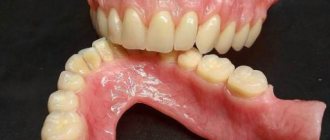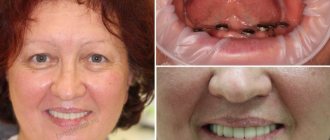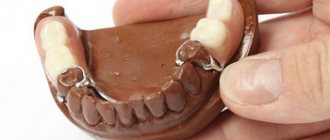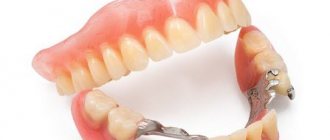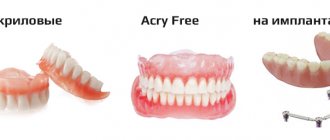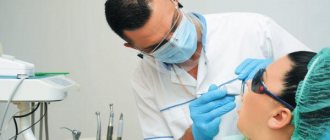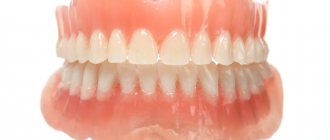The upper jaw is exposed to less chewing load than the lower jaw. Therefore, the bone here is thinner and looser, which complicates the installation of implants. However, if the manipulations are performed correctly, the probability of implantation success is quite high. According to statistics, the average survival rate of implants in the upper jaw is 96-97%. A higher result (99%) is demonstrated by basal implantation with immediate loading, slightly lower results (96-97%) with the classical two-stage technique.
What are the features of upper teeth implantation?
1. After tooth loss, the bone tissue of the upper jaw atrophies (that is, decreases in volume) faster than the lower jaw. Already after 5-6 months, most patients are diagnosed with acute bone deficiency at the sites of defects.
2. Due to the fact that the upper jaw bone is loose, implants “fuse” with it longer. If on the lower jaw the systems take root on average in 2-3 months, then on the upper jaw - in 3-4.
3. Implantation of the upper chewing teeth requires special care, since the maxillary sinuses are located in close proximity to them. Accidental puncture of the sinus threatens the development of infectious complications.
4. When implanting the anterior teeth of the upper jaw, the doctor should pay increased attention to aesthetics. After all, these teeth are responsible for the formation of a smile.
Expert opinion
Vladimir Aleksandrovich Voznyuk
maxillofacial surgeon, implantologist
Experience: more than 33 years
In whatever area of the upper jaw a “gap” is formed - frontal, lateral or chewing - a negative impact on the body is inevitable. The fact that the absence of a tooth is not noticeable from the outside is not an argument in favor of refusing restoration. Decreased quality of chewing function, malocclusion, increased load on neighboring teeth, and as a result - their rapid destruction - these are just some of the problems that will become obvious in the near future. Implantation of teeth in the upper jaw will stop bone atrophy, ensure normal chewing and consumption of any usual food, and prevent early aging of the face. When planning implantation, it is important to choose a reliable clinic and specialist who will individualize the approach to the problem and propose a protocol that is optimal for you.
Implantation options for small defects in the upper dentition
In the absence of 1-3 consecutive teeth, patients are recommended to receive classical implantation. This is the only technique that allows you to work in a limited volume of bone.
The procedure is carried out in two stages:
- At the first stage, the doctor peels off the gum flap and forms a bed in the bone with a special tool, in which he places the root part of the implant. The gum is sutured. Next, the doctor and patient wait 3-4 months for the structure to take root—during this time, bone cells penetrate the pores of the implant and literally fuse with it.
- In the second stage, the gums are reopened. A gum former is installed on the artificial root, which helps create a beautiful contour of the soft tissue around the neck of the implant. After 2 weeks, the former is replaced with a supragingival head (abutment), on which the crown is fixed.
In total, classical dental implantation in the upper jaw takes about six months.
Important note: if the results of the examination reveal that the patient has bone atrophy, he undergoes an additional procedure before implantation - bone grafting. As a rule, after such an operation, another 3-6 months must pass before the bone volume is restored and becomes suitable for the installation of implants.
Top brands
Global implant manufacturers often produce brand lines with different diameters and lengths. This allows you to choose the most suitable option for a particular patient, taking into account the structural features and condition of the maxillary tissues. Popular brands:
- Nobel Active (Nobel company, USA) - high-quality titanium roots with a minimum diameter and long enough to reach the basal layer of the jaw tissue; have a special coating that speeds up the implantation process; installed on the front teeth, provided there is a sufficient amount of gum tissue;
- PURE (Straumann company, Switzerland) – zirconium implants, beautiful and durable, coated with a composition that makes the roots take root better; suitable for any units of the dentition;
- Bone Level Tapered Small One (Strauman) – implants made of ultra-strong material Roxolid with a minimum diameter; ideal for the smile area of the upper jaw, even with slight atrophy of bone tissue;
- Bone Level Tapered (Straumann) – also Roxolid material, diameter and length are different; in the smile area, implants with a small diameter and sufficient length are used to penetrate the basal layer, on chewing units - standard ones; a feature of this design is its manufacturing technology, as a result of which artificial roots take root better;
- Hi-Tec (Hi-Tech company, Israel) – high-quality titanium implants with different diameters; this allows you to select a model for any tooth in the dentition of the upper jaw; The quality is practically not inferior to the Nobel brand, but their price is much lower.
Implants from popular brands
The dentist and the patient decide which brands are best suited in a particular case. The effectiveness of implantation depends not only on the quality and price of the brand, but also on the skill of the implantologist. Even inexpensive models installed by a qualified specialist will take root well in the tissues of the jaw, will last and will be a reliable support for the prosthesis.
Implantation options for medium and large defects
If there are a large number of missing teeth, classical implantation becomes impractical. Firstly, due to the high level of trauma, the risks of intervention increase many times over. Secondly, such treatment is expensive for patients. Therefore, patients are recommended methods of one-stage implantation of the upper jaw, which reduce the number of surgical procedures and avoid the procedure of bone augmentation:
- Basal implantation .
It is used in the absence of 3 or more missing teeth in a row (including a completely toothless jaw). The essence of the method is that implants are installed in the deepest and densest layers of the jaw, which do not thin out over time. As a result, the systems are firmly and securely attached to the bone. During basal implantation of the upper teeth, the gums are minimally injured, since the implants are screwed in without incisions, through small punctures. Already 3 days after the operation, a fixed prosthesis is fixed on the implants. Along the edge of the prosthesis there is an acrylic gum, which hides the imperfections of the patient’s own mucosa and provides a good aesthetic result. Due to its lightness, the design does not interfere with the normal healing of implants. Almost immediately after prosthetics, the patient can chew food fully. - Methods ALL ON 4 or ALL ON 6.
Indicated for moderate bone atrophy in the patient and complete absence of teeth. Only 4 or 6 implants are installed in a toothless jaw. Of these, two are vertical, in place of the front teeth, the rest are in the lateral areas of the jaw. This approach allows you to bypass the most atrophied areas and fix the implants where more bone is preserved. Prosthetics are performed on the same day or 2-3 days after surgery. Patients are fitted with the same fixed prosthesis as with the basal implantation method.
The doctor selects a suitable implantation technique in the absence of upper teeth based on the results of an examination and computed tomography.
Are full dentures supported by mini-implants?
The design is not based on the required level of strength, so mini-implants cannot hold a non-removable structure and provide a full chewing load. Their purpose is to support removable dentures in the interim period, when the installation of implants is postponed for objective reasons, for example, to treat detected caries. The reason is that mini-implants are smaller and thinner than standard models, are not designed for total load and can last no more than 1-2 years.
Stages of implant installation
- Preparing for treatment .
On the first visit, the doctor examines the oral cavity and talks with the patient. Possible treatment options are discussed. If there are no obvious contraindications to implantation, the patient is sent for a computed tomography (CT) scan and sometimes additionally for a blood test. - Treatment planning.
CT data is loaded into a special program that recreates a three-dimensional model of the patient's jaw. Based on this information, suitable implant models are selected and their installation locations are determined. A surgical template is then created in the laboratory using the 3D model to be used for the operation. - Implantation of upper teeth.
Under local anesthesia, through incisions (with the classical method and ALL ON 4/6 methods) or through small punctures (with the basal method), the implants are implanted into the jaw. - Prosthetics .
Depending on the protocol used, the dentures are fixed on the implants for 2-3 days or several months later.
Digital diagnostics - to eliminate risks
A Sirona Galileos computed tomograph (Germany) with ENT mode settings is used
- Assessment of bone parameters in the implantation zone, location of the maxillary sinuses
- Analysis of the condition and position of tooth roots during single-stage implantation
- 3D operation planning, creation of navigation templates
Cost of implantation of upper teeth in Moscow
The cost of implantation depends on the clinic, the type of implants and the patient’s situation. On average, the price for installing one implant varies from 30,000 to 60,000 rubles. Complete jaw implantation will cost 200,000 - 400,000 rubles.
ROOTT centers support an affordable pricing policy. The cost of installing one classic implant (two-stage protocol) in our clinics is 32,000 rubles. The production of a crown is paid separately (from 28 thousand rubles).
Implantation of more than 3 upper teeth using the basal protocol will cost an average of 80,000 -110,000 rubles. And the price for a complete restoration of the dentition will be 265,000 rubles - this price already includes the required number of implants, X-ray diagnostics, doctor’s work and a fixed prosthesis.
Where to go for upper jaw implantation in Moscow
The main feature of dental implantation in the upper jaw is its structure. The bone here is more porous and susceptible to the rapid development of atrophic processes after tooth extraction. The algorithm for installing implants in the maxillary bone often requires a preliminary sinus lift.
After administering local anesthesia, the surgeon makes an incision in the gum, exposes the bone and prepares the implant bed. At this stage, the implantologist must have great intuition and experience. The next step, that is, installation of the implant, determines the success of the procedure. Finally, the implant is closed with a closure or healing screw, or a temporary prosthesis is placed on it. If the procedure was performed under local anesthesia, the patient can go home after a short time. If the anesthesiologist has performed sedation, he decides how long the patient will be monitored in the clinic. Usually this is no more than half an hour.
The choice of dentistry for dental implantation of the upper jaw is extremely important, because the final result depends on the experience of specialists and the level of equipment of the clinic. The approximate cost of this dental service in Moscow clinics is given in the table below.
| Name | Clinic address | Service cost |
| ROOTT |
|
|
| Shandora | Moscow, Kolpachny lane, 6, building 4. |
|
| Dentistry Grand Smile | Moscow, st. Miklouho-Maklaya 43 (metro station Belyaevo, Yugo-Zapadnaya, Kaluzhskaya) | Prices for dental implantation from 30,000 rubles (MIS system) to 70,000 rubles (Nobel) |
| Dentistry City Dent | Moscow, st. Novocheremushkinskaya, 57 | Implantation of one tooth with the Astra Tech system – 52,000 rubles |
| Dentistry Vita-Stom |
| Implantation of one tooth with the Straumann system (Switzerland) – from 32,000 rubles. |
The first two weeks after surgery, during which tissue healing occurs, are key to the success of the overall treatment, regardless of whether you had your front teeth restored or your posterior upper teeth implanted. At this time, it is very important to follow the doctor’s recommendations:
- For 7-10 days, the implant area must be washed with saline solution after each meal to maintain proper cleanliness.
- If during the first 2 weeks the patient experiences discomfort when using dentures (excessive pressure), it is necessary to contact the dentist to adapt the dentures to the anatomical conditions of the oral cavity.
- After the procedure, it is recommended to eat only liquid and semi-liquid foods.
- Bruises and hematomas are not a cause for concern; they are a common complication that does not require additional treatment.
Other jobs
Examples of work “Before” and “After”
Restoration of all teeth on the upper and lower jaw - basal implantation
Case: partial absence of teeth on the upper and lower jaw, complicated by severe periodontitis (tooth mobility).
Restoration of the upper jaw - basal implantation (March 2012)
Case: partial absence of teeth in the upper jaw, the remaining teeth are mobile and cannot be restored.
Restoration of the upper jaw - basal implantation
Case: the patient came to the Simpladent clinic with complaints of a fracture of teeth under a metal-ceramic structure and mobility of the latter in the upper jaw.
Basal implantation in case of complete absence of teeth in the upper jaw
Case: partial absence of teeth in the upper jaw, the patient also complained of mobility of the bridge, the remaining supporting teeth were destroyed.
Advantages of full implantation in terms of ease of eating
You can calmly enjoy the taste of your favorite dishes only with complete dental implantation, including chewing ones. In this case, the load is distributed evenly and you don’t have to change your taste preferences. For removable dentures, such freedom is unattainable due to the design itself. It relies on the mucous membrane, which is full of nerve endings. Hence the discomfort and the need to constantly clean the prosthesis and ensure its stability with the help of special adhesives.
